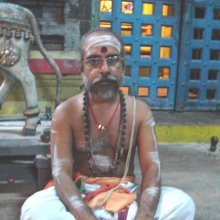Shivacarya, Śivācārya, Shiva-acarya: 3 definitions
Introduction:
Shivacarya means something in Hinduism, Sanskrit, the history of ancient India. If you want to know the exact meaning, history, etymology or English translation of this term then check out the descriptions on this page. Add your comment or reference to a book if you want to contribute to this summary article.
The Sanskrit term Śivācārya can be transliterated into English as Sivacarya or Shivacarya, using the IAST transliteration scheme (?).
Alternative spellings of this word include Shivacharya.
Images (photo gallery)
India history and geography
Source: Shodhganga: Temple management in the Āgamas (history)Śivācārya (शिवाचार्य) or Śivabrāhmaṇa refers to Ādiśaiva priests also known as Ācārya.—The priest scholars in the field were Śivācāryas of famous maṭh lineages. There were experts in all four paths covered by the Āgamas, namely carya, kriya, yoga and jñāna. Within the temple milieu, there were specialists in various types of ritual—alaṃkāra, abhiṣeka, utsava, and so on. The Śivācāryas were fluent in both Sanskrit and Tamil and frequently composed scholarly works in both languages. Several of the canonical works in Tamil were composed by Aruḷnandi Śivācārya and Umāpati Śivācārya and Kacciappa Śivācārya. The celebrated paddhatis on the Āgamas are composed by Śivācāryas.

The history of India traces the identification of countries, villages, towns and other regions of India, as well as mythology, zoology, royal dynasties, rulers, tribes, local festivities and traditions and regional languages. Ancient India enjoyed religious freedom and encourages the path of Dharma, a concept common to Buddhism, Hinduism, and Jainism.
Languages of India and abroad
Sanskrit dictionary
Source: Cologne Digital Sanskrit Dictionaries: Aufrecht Catalogus CatalogorumŚivācārya (शिवाचार्य) as mentioned in Aufrecht’s Catalogus Catalogorum:—Vijñānabhairavoddyota. Vijñānabhairavoddyotasaṃgraha, written under a king Sukhajīvana.
Śivācārya has the following synonyms: Śivasvāmin, Śivopādhyāya.
Sanskrit, also spelled संस्कृतम् (saṃskṛtam), is an ancient language of India commonly seen as the grandmother of the Indo-European language family (even English!). Closely allied with Prakrit and Pali, Sanskrit is more exhaustive in both grammar and terms and has the most extensive collection of literature in the world, greatly surpassing its sister-languages Greek and Latin.
Kannada-English dictionary
Source: Alar: Kannada-English corpusŚivācārya (ಶಿವಾಚಾರ್ಯ):—[noun] a pontiff of Vīraśaiva religion.
Kannada is a Dravidian language (as opposed to the Indo-European language family) mainly spoken in the southwestern region of India.
See also (Relevant definitions)
Partial matches: Shiva, Acarya, Civa.
Ends with: Aghorashivacarya, Vyomashivacarya.
Full-text (+1): Shiva acarya, Shivabrahmana, Vyomashivacarya, Civacariyar, Ratnatrayoddyota, Samhitakhandanaratna, Shivopadhyaya, Caivacakkaravartti, Caivaculamani, Caiva-kalalayacakkaravartti, Appayyadikshita, Shataratnasamgraha, Hiranyagarbhadana, Shaivacarya, Arcaka, Shivaprakasha, Shivasvamin, Pasha, Pradhanacarya, Nityapuja.
Relevant text
Search found 10 books and stories containing Shivacarya, Śivācārya, Shiva-acarya, Śiva-ācārya, Sivacarya, Siva-acarya; (plurals include: Shivacaryas, Śivācāryas, acaryas, ācāryas, Sivacaryas). You can also click to the full overview containing English textual excerpts. Below are direct links for the most relevant articles:
Kashyapa Shilpa-shastra (study) (by K. Vidyuta)
A History of Indian Philosophy Volume 5 (by Surendranath Dasgupta)
Part 4 - Śaiva Philosophy according to Bhoja and his commentators < [Chapter XXXVIII - Śaiva Philosophy in some of the Important texts]
Part 6 - Vātulāgama < [Chapter XXXIV - Literature of Southern Śaivism]
Part 7 - Vatula-tantra < [Chapter XXXIV - Literature of Southern Śaivism]
Shaiva Upanishads (A Critical Study) (by Arpita Chakraborty)
13. Forms are for Visualization < [Chapter 5 - Essence of Pañcabrahma Upaniṣad]
The Shiva Purana (by J. L. Shastri)
Chapter 20 - Special consecration < [Section 7.2 - Vāyavīya-saṃhitā (2)]
The Religion and Philosophy of Tevaram (Thevaram) (by M. A. Dorai Rangaswamy)
The Skanda Purana (by G. V. Tagare)
Chapter 9 - The Vulture’s Story < [Section 2 - Kaumārikā-khaṇḍa]
Related products


